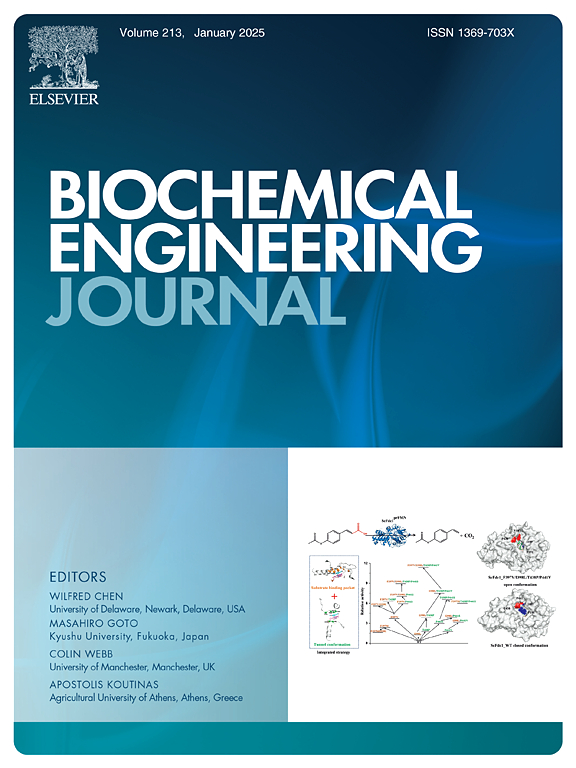Machine learning-based predictive modeling and optimization: Artificial neural network-genetic algorithm vs. response surface methodology for black soldier fly (Hermetia illucens) farm waste fermentation
IF 3.7
3区 生物学
Q2 BIOTECHNOLOGY & APPLIED MICROBIOLOGY
引用次数: 0
Abstract
Recognizing the complexity of non-linear and interdependent biological processes, this study compared the predictive performance of artificial neural network (ANN) models with response surface methodology regression based (RB) models. The research focused on the biological transformation of black soldier fly (Hermetia illucens) farm waste into chitin, facilitated by Lactobacillus paracasei. Key parameters of time (1–7 days), temperature (30–40 °C), substrate concentration (7.5–20 wt%), and inoculum concentration (5–15 v/v%), were evaluated for their impact on demineralization and deproteinization subprocesses and subsequently optimized. It was determined that the ANN models outperformed RB models, with R² values of 0.950 and 0.959 for DP% and DD%, compared to 0.677 and 0.720 for RB models. While both models, optimized using a multi-objective genetic algorithm (MOGA) and a desirability function respectively, produced comparable optimal results, differences emerged in process variable analysis. Main effects plots (RB) and one way partial dependence plots (ANN) revealed conflicting parameter influences, highlighting the limitations of regression models in complex systems. This study highlights the superiority of ANN-MOGA in addressing biological complexity and recommends its use especially if RB models show suboptimal predictive capabilities.
基于机器学习的预测建模与优化:人工神经网络、遗传算法与黑兵蝇(Hermetia illucens)农场废弃物发酵响应面方法
认识到非线性和相互依存的生物过程的复杂性,本研究比较了人工神经网络(ANN)模型和基于响应面方法回归(RB)模型的预测性能。研究了在副干酪乳杆菌的促进下,将黑兵蝇(Hermetia illucens)农场废弃物转化为几丁质。对时间(1-7天)、温度(30-40°C)、底物浓度(7.5-20 wt%)和接种量浓度(5-15 v/v%)等关键参数对脱矿和脱蛋白亚过程的影响进行了评估,并随后进行了优化。结果表明,ANN模型的DP%和DD%的R²值分别为0.950和0.959,优于RB模型的0.677和0.720。虽然两种模型分别使用多目标遗传算法(MOGA)和可取性函数进行优化,产生了类似的最优结果,但在过程变量分析中出现了差异。主效应图(RB)和单向偏相关图(ANN)显示了相互冲突的参数影响,突出了回归模型在复杂系统中的局限性。这项研究强调了ANN-MOGA在解决生物复杂性方面的优势,并建议在RB模型显示次优预测能力的情况下使用它。
本文章由计算机程序翻译,如有差异,请以英文原文为准。
求助全文
约1分钟内获得全文
求助全文
来源期刊

Biochemical Engineering Journal
工程技术-工程:化工
CiteScore
7.10
自引率
5.10%
发文量
380
审稿时长
34 days
期刊介绍:
The Biochemical Engineering Journal aims to promote progress in the crucial chemical engineering aspects of the development of biological processes associated with everything from raw materials preparation to product recovery relevant to industries as diverse as medical/healthcare, industrial biotechnology, and environmental biotechnology.
The Journal welcomes full length original research papers, short communications, and review papers* in the following research fields:
Biocatalysis (enzyme or microbial) and biotransformations, including immobilized biocatalyst preparation and kinetics
Biosensors and Biodevices including biofabrication and novel fuel cell development
Bioseparations including scale-up and protein refolding/renaturation
Environmental Bioengineering including bioconversion, bioremediation, and microbial fuel cells
Bioreactor Systems including characterization, optimization and scale-up
Bioresources and Biorefinery Engineering including biomass conversion, biofuels, bioenergy, and optimization
Industrial Biotechnology including specialty chemicals, platform chemicals and neutraceuticals
Biomaterials and Tissue Engineering including bioartificial organs, cell encapsulation, and controlled release
Cell Culture Engineering (plant, animal or insect cells) including viral vectors, monoclonal antibodies, recombinant proteins, vaccines, and secondary metabolites
Cell Therapies and Stem Cells including pluripotent, mesenchymal and hematopoietic stem cells; immunotherapies; tissue-specific differentiation; and cryopreservation
Metabolic Engineering, Systems and Synthetic Biology including OMICS, bioinformatics, in silico biology, and metabolic flux analysis
Protein Engineering including enzyme engineering and directed evolution.
 求助内容:
求助内容: 应助结果提醒方式:
应助结果提醒方式:


